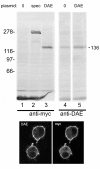The Drosophila Anion Exchanger (DAE) lacks a detectable interaction with the spectrin cytoskeleton
- PMID: 20573195
- PMCID: PMC2901199
- DOI: 10.1186/1477-5751-9-5
The Drosophila Anion Exchanger (DAE) lacks a detectable interaction with the spectrin cytoskeleton
Abstract
Background: Current models suggest that the spectrin cytoskeleton stabilizes interacting ion transport proteins at the plasma membrane. The human erythrocyte anion exchanger (AE1) was the first membrane transport protein found to be associated with the spectrin cytoskeleton. Here we evaluated a conserved anion exchanger from Drosophila (DAE) as a marker for studies of the downstream effects of spectrin cytoskeleton mutations.
Results: Sequence comparisons established that DAE belongs to the SLC4A1-3 subfamily of anion exchangers that includes human AE1. Striking sequence conservation was observed in the C-terminal membrane transport domain and parts of the N-terminal cytoplasmic domain, but not in the proposed ankyrin-binding site. Using an antibody raised against DAE and a recombinant transgene expressed in Drosophila S2 cells DAE was shown to be a 136 kd plasma membrane protein. A major site of expression was found in the stomach acid-secreting region of the larval midgut. DAE codistributed with an infolded subcompartment of the basal plasma membrane of interstitial cells. However, spectrin did not codistribute with DAE at this site or in anterior midgut cells that abundantly expressed both spectrin and DAE. Ubiquitous knockdown of DAE with dsRNA eliminated antibody staining and was lethal, indicating that DAE is an essential gene product in Drosophila.
Conclusions: Based on the lack of colocalization and the lack of sequence conservation at the ankyrin-binding site, it appears that the well-characterized interaction between AE1 and the spectrin cytoskeleton in erythrocytes is not conserved in Drosophila. The results establish a pattern in which most of the known interactions between the spectrin cytoskeleton and the plasma membrane in mammals do not appear to be conserved in Drosophila.
Figures





Similar articles
-
Unexpected complexity in the mechanisms that target assembly of the spectrin cytoskeleton.J Biol Chem. 2008 May 2;283(18):12643-53. doi: 10.1074/jbc.M800094200. Epub 2008 Feb 19. J Biol Chem. 2008. PMID: 18287096 Free PMC article.
-
Genetic studies of spectrin in the larval fat body of Drosophila melanogaster: evidence for a novel lipid uptake apparatus.Genetics. 2013 Nov;195(3):871-81. doi: 10.1534/genetics.113.155192. Epub 2013 Sep 13. Genetics. 2013. PMID: 24037266 Free PMC article.
-
Mapping the binding sites of human erythrocyte ankyrin for the anion exchanger and spectrin.J Biol Chem. 1990 Jun 25;265(18):10589-96. J Biol Chem. 1990. PMID: 2141335
-
Molecular physiology of SLC4 anion exchangers.Exp Physiol. 2006 Jan;91(1):153-61. doi: 10.1113/expphysiol.2005.031765. Epub 2005 Oct 20. Exp Physiol. 2006. PMID: 16239253 Review.
-
The molecular basis for membrane - cytoskeleton association in human erythrocytes.J Cell Biochem. 1982;18(1):49-65. doi: 10.1002/jcb.1982.240180106. J Cell Biochem. 1982. PMID: 6461664 Review.
Cited by
-
The divergence, actions, roles, and relatives of sodium-coupled bicarbonate transporters.Physiol Rev. 2013 Apr;93(2):803-959. doi: 10.1152/physrev.00023.2012. Physiol Rev. 2013. PMID: 23589833 Free PMC article. Review.
-
Na+ /H+ exchange via the Drosophila vesicular glutamate transporter mediates activity-induced acid efflux from presynaptic terminals.J Physiol. 2017 Feb 1;595(3):805-824. doi: 10.1113/JP273105. Epub 2016 Nov 13. J Physiol. 2017. PMID: 27641622 Free PMC article.
-
Drosophila anion exchanger 2 is required for proper ovary development and oogenesis.Dev Biol. 2019 Aug 15;452(2):127-133. doi: 10.1016/j.ydbio.2019.04.018. Epub 2019 May 7. Dev Biol. 2019. PMID: 31071312 Free PMC article.
-
Anatomy and Physiology of the Digestive Tract of Drosophila melanogaster.Genetics. 2018 Oct;210(2):357-396. doi: 10.1534/genetics.118.300224. Genetics. 2018. PMID: 30287514 Free PMC article. Review.
-
Genetically encoded pH-indicators reveal activity-dependent cytosolic acidification of Drosophila motor nerve termini in vivo.J Physiol. 2013 Apr 1;591(7):1691-706. doi: 10.1113/jphysiol.2012.248377. Epub 2013 Jan 7. J Physiol. 2013. PMID: 23401611 Free PMC article.
References
-
- Lux SE, Palek J. In: Blood: Principles and practice of hematology. Handin RI, Lux SE, Stossel TP, editor. Philadelphia: J.B. Lippincott Co.; 1995. Disorders of the Red Cell Membrane; pp. 1701–1818.
-
- Bennett V, Baines AJ. Spectrin and ankyrin-based pathways: Metazoan inventions for integrating cells into tissues. Physiol Rev. 2001. pp. 1353–1388. - PubMed
-
- Dubreuil RR. In: Advance in Molecular Cell Biology. Khurana S, editor. Vol. 37. New York:Elsevier; 2006. Spectrin function: A survey of genetic systems from Drosophila to humans; pp. 68–88.
Publication types
MeSH terms
Substances
Grants and funding
LinkOut - more resources
Full Text Sources
Molecular Biology Databases
Miscellaneous

